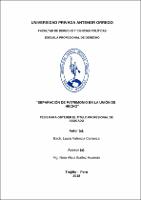Mostrar el registro sencillo del ítem
Separación de patrimonio en la unión de hecho
| dc.contributor.advisor | Ibañez Huamán, Nora Alicia | |
| dc.contributor.author | Valencia Carranza, Laura | |
| dc.creator | Valencia Carranza, Laura | |
| dc.date.accessioned | 2018-09-27T22:12:22Z | |
| dc.date.available | 2018-09-27T22:12:22Z | |
| dc.date.issued | 2018 | |
| dc.identifier.uri | https://hdl.handle.net/20.500.12759/4351 | |
| dc.description.abstract | El presente trabajo de investigación tiene como objetivo general determinar los fundamentos jurídicos por los cuales debe incorporarse el régimen de separación de patrimonio en la unión de hecho. La investigación es básica y descriptiva, dentro de ese marco se recopiló información doctrinaria, legislativa y jurisprudencial para la elaboración de los capítulos del marco teórico, los métodos generales que se aplicaron fueron el inductivo-deductivo y el analítico-sintético, y dentro de los métodos específicos se emplearon el método dogmático y el exegético, en cuanto a los instrumentos de recolección de datos fueron de utilidad las fichas de registro y de investigación. En lo que atañe a los resultados más importantes se obtuvo que la familia es un grupo social organizado y una institución social con funciones de formación, socialización y de control social, la constitución vigente regula un pluralismo familiar ya que se reconoce tanto al matrimonio como a la unión de hecho estable como instituciones familiares, sus elementos objetivos son la convivencia, singularidad, publicidad, estabilidad y como elemento subjetivo la manifestación de voluntad, en la legislación nacional solo la sociedad de gananciales en cuanto le sea aplicable existe como régimen único, legal y forzoso para la unión de hecho. La conclusión principal es que legalmente es posible la incorporación del régimen de separación de patrimonio en la unión de hecho. | es_PE |
| dc.description.abstract | The general objective of this research work is determine the legal bases by which the regime of separation of assets in the de facto union should be incorporated. The research is basic and descriptive, within that framework doctrinal, legislative and jurisprudential information was compiled for the elaboration of the chapters of the theoretical framework, the general methods that were applied were the inductivedeductive and the analytic-synthetic, and within the Specific methods were used the dogmatic and the exegetical method, in terms of data collection instruments were useful record and research files. Regarding the most important results, it was found that the family is an organized social group and a social institution with functions of training, socialization and social control, the current constitution regulates a family pluralism since both marriage and marriage are recognized. the union of stable fact as family institutions, its objective elements are the coexistence, uniqueness, publicity, stability and as a subjective element the manifestation of will, in the national legislation only the community of acquisitions as it is applicable exists as a single, legal regime and forced for the de facto union. The main conclusion is that legally it is possible to incorporate the regime of separation of assets in the de facto union. | en_US |
| dc.description.uri | Tesis | es_PE |
| dc.format | application/pdf | es_PE |
| dc.language.iso | spa | es_PE |
| dc.publisher | Universidad Privada Antenor Orrego - UPAO | es_PE |
| dc.relation.ispartofseries | T_DERE_444 | |
| dc.rights | info:eu-repo/semantics/openAccess | es_PE |
| dc.source | Universidad Privada Antenor Orrego | es_PE |
| dc.source | Repositorio Institucional - UPAO | es_PE |
| dc.subject | Sociedad de gananciales | es_PE |
| dc.subject | Separación de patrimonio | es_PE |
| dc.title | Separación de patrimonio en la unión de hecho | es_PE |
| dc.type | info:eu-repo/semantics/bachelorThesis | es_PE |
| thesis.degree.level | Título Profesional | es_PE |
| thesis.degree.grantor | Universidad Privada Antenor Orrego. Facultad de Derecho y Ciencias Politicas | es_PE |
| thesis.degree.name | Abogado | es_PE |
| thesis.degree.discipline | Derecho | es_PE |
Ficheros en el ítem
Este ítem aparece en la(s) siguiente(s) colección(es)
-
Derecho [428]

